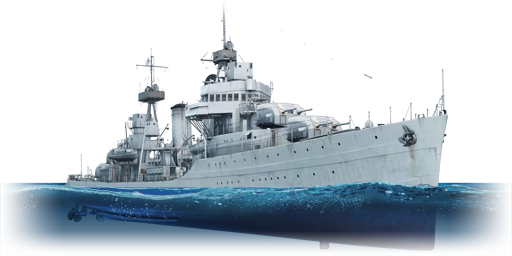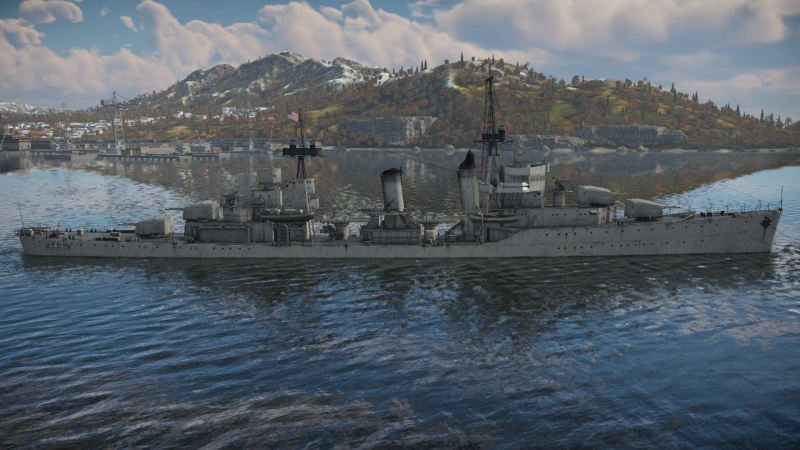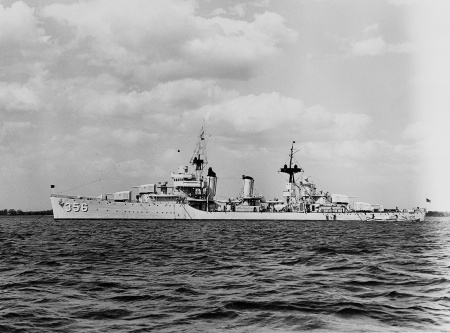USS Porter
Contents
Description
The Porter-class, USS Porter (DD-356), 1941 is a rank III American destroyer with a battle rating of 5.0 (AB/RB/SB). It was introduced in Update 1.95 "Northern Wind".
General info
Survivability and armour
As with most American destroyers, USS Porter is protected against 5-6-inch high explosive rounds by a .5-inch anti-fragmentation armour belt. This is incapable of stopping armour-piercing rounds, but significantly reduces splinter damage inside the hull, massively reducing the amount of damage done inside the ship. This belt covers the machinery spaces amidships, however the rest of the hull is left unprotected by any armour.
USS Porter's magazines lie underneath the aft two turrets slightly above the waterline, leaving them exposed to enemy fire. Any hit to this area of the ship will almost certainly result in total loss of the ship. Captains of USS Porter should make every effort to make this area difficult to hit, preferably using other object such as land, or erratic movements. When possible captains should take hits amidships where the armour belt can soak up some of the damage. Porter houses 194 crewmen; less that that of similar rank destroyers such as the Gearing-class destroyers, resulting in slightly lower survivability under fire than other American destroyers.
Mobility
The USS Porter, with its top speed of 37 kn, is the fastest destroyer in the United States Navy bluewater fleet. She will be easily capable of taking any objectives, and the high speed of the vessel can allow her to make it to critical areas before other, slower destroyers are able. Taking roughly 30 seconds to accelerate to flank speed, and only 37 seconds to come to a halt, the Porter is very responsive to engine room commands. The rudder responds swiftly, taking less than a second at high speed to begin moving the ship. Speed falls to a respectable 26 kn when in a sustained turn, but continuous evasive action is still ill-advised, for risk of making Porter a slow and vulnerable target.
| Mobility Characteristics | |||||
|---|---|---|---|---|---|
| Game Mode | Upgrade Status | Maximum Speed (km/h) | Turn Time (s) | Turn Radius (m) | |
| Forward | Reverse | ||||
| AB | Stock | 62 | 26 | ~130.35 | ~247.8 |
| Upgraded | 84 | 35 | ___ | ___ | |
| RB/SB | |||||
| Upgraded | 69 | 29 | ___ | ___ | |
Modifications and economy
Armament
Primary armament
Eight 5-inch cannons make the Porter one of the most dangerous destroyers in the game. That being said, due to the turrets being of a pre-war design, they have a relatively slow reaction time, as they turn rather slowly. Hence, the Porter's require a player to think of precisely when and where an enemy will come from. The rate of fire can easily be cut to under twenty rounds per minute, but the guns have a poor arc and velocity, and thus excel in close to medium range engagements.
| Penetration statistics | |||||||
|---|---|---|---|---|---|---|---|
| Ammunition | Type of warhead |
Penetration @ 0° Angle of Attack (mm) | |||||
| 1,000 m | 2,500 m | 5,000 m | 7,500 m | 10,000 m | 15,000 m | ||
| AAC Mk.34 | HE | 36 | 36 | 36 | 36 | 36 | 36 |
| Common Mk.32 | Common | 124 | 103 | 77 | 58 | 46 | 37 |
| SP Common Mk.46 | SP Common | 150 | 125 | 93 | 71 | 56 | 45 |
| AAVT Mk.31 | HE-VT | 36 | 36 | 36 | 36 | 36 | 36 |
| Shell details | |||||||||
|---|---|---|---|---|---|---|---|---|---|
| Ammunition | Type of warhead |
Velocity (m/s) |
Projectile mass (kg) |
Fuse delay (s) |
Fuse sensitivity (mm) |
Explosive mass (TNT equivalent) (g) |
Ricochet | ||
| 0% | 50% | 100% | |||||||
| AAC Mk.34 | HE | 792 | 25 | 0 | 0.1 | 3,220 | 79° | 80° | 81° |
| Common Mk.32 | Common | 792 | 24.49 | 0.01 | 6 | 1,150 | 47° | 60° | 65° |
| SP Common Mk.46 | SP Common | 792 | 25 | 0.01 | 6 | 906.5 | 48° | 63° | 71° |
| Proximity-fused shell details | |||||||||||
|---|---|---|---|---|---|---|---|---|---|---|---|
| Ammunition | Type of warhead |
Velocity (m/s) |
Projectile mass (kg) |
Fuse delay (m) |
Fuse sensitivity (mm) |
Arming distance (m) |
Trigger radius (m) |
Explosive mass (TNT equivalent) (g) |
Ricochet | ||
| 0% | 50% | 100% | |||||||||
| AAVT Mk.31 | HE-VT | 792 | 25 | 0 | 0.1 | 457 | 23 | 3,220 | 79° | 80° | 81° |
Secondary armament
The USS Porter has two 1.1-inch/75 "Chicago Pianos", one mounted forward of the bridge and the other mounted to the aft of the rear fire director. The 1.1-inch lacks punch when compared to the more effective 40 mm Bofors found on later USN destroyers, and while useful in close quarters, cannot be relied on to be able to get reliable hits until a plane is either about to or has already released its payload. Captains are therefore advised to utilize the AAVT shells on the main guns when attempting to destroy aircraft in the beginning of the attack run, and allow the 1.1-inch mounts to serve as a deterrent and final line of defense for the ship.
| Penetration statistics | |||||||
|---|---|---|---|---|---|---|---|
| Ammunition | Type of warhead |
Penetration @ 0° Angle of Attack (mm) | |||||
| 10 m | 100 m | 500 m | 1,000 m | 1,500 m | 2,000 m | ||
| 1.1 inch Mk.1 HE-T | HEF-T* | 2 | 2 | 2 | 2 | 2 | 2 |
| Shell details | |||||||||
|---|---|---|---|---|---|---|---|---|---|
| Ammunition | Type of warhead |
Velocity (m/s) |
Projectile mass (kg) |
Fuse delay (m) |
Fuse sensitivity (mm) |
Explosive mass (TNT equivalent) (g) |
Ricochet | ||
| 0% | 50% | 100% | |||||||
| 1.1 inch Mk.1 HE-T | HEF-T* | 823 | 0.42 | 0 | 0.1 | 14.7 | 79° | 80° | 81° |
Anti-aircraft armament
With only two 12.5 machine guns, some PT boats have better dedicated AA weaponry. Regardless, they can still deter some planes, but cannot cover the front of the ship at all.
Additional armament
With 15 torpedoes, with a decent range and speed, the Porter can be a torpedo boat, but aside from serving as an ammo rack, in game, the high speed and rough terrain makes carrying torpedoes a very situational weapon, and one that largely shines in Naval EC
Usage in battles
Destroyer Hunter
With double the guns of almost every destroyer around its BR, the Porter is a great anti destroyer hunter, a role it should stick to in an up-tier given its low calibre main battery. Due to its large size and poor lacklustre armour (which only helps against HE fire), the Porter should refrain from a cruiser gun duel, and instead cap points or cover more protected or faster allies in the shallow and narrow areas around caps.
Pros and cons
Pros:
- 8 x 5-inch dual-purpose guns give it excellent firepower
- Decent rate of fire
- Good mobility
- Utilizes anti-fragmentation armour to protect the crew and internal components
- Carries 16 torpedoes, allowing it to create an area of denial at mid-to-long ranges
Cons:
- AA power is lacklustre due to only 2 x 12.7 mm AN-M2 Browning machine guns and 2 x 1.1"/75 calibre guns.
- The turrets lack any true armour making them vulnerable, much like its successor, USS Somers
- Shorter torpedo distance compared to its contemporaries
- Has a small crew size of 194
History
The USS porter (DD-356) was the lead ship of her class of large destroyers built for the United States Navy before the Second World War. Designed as a destroyer leader to lead large groups of destroyers in combat, the Porter was built with a substantial main armament, making her one of the most heavily-armed destroyers of her time. Porter saw some service during the Second World War in the pacific theatre, and was eventually scuttled after being torpedoed at the Battle of the Santa Cruz Islands.
Design and development
During the interwar period, the United States Navy built a number of large destroyers, or destroyer leaders, designed to lead destroyer flotillas in future conflicts. The first of these classes, the Porter class, was designed and built in the early 1930s. Porter was the lead ship of this class, and was laid down in December 1933. She was launched two years later in December 1935, and commissioned by August 1936.
Porter carried a main armament of eight 5-inch (127 mm) guns in four dual mounts - this was an exceptionally-heavy armament for a destroyer, matched only by her successor class, the Somers-class. Her anti-aircraft armament was extremely weak, with just two quadruple 28 mm (1.1 inch) Chicago Piano anti-aircraft mounts and two 12.7 mm (0.5 inch) AN/M2 machine guns. Porter had a massive engine block delivering 50 000 shaft horsepower, allowing her to reach a maximum speed of 35 knots. However, unlike the succeeding Somers-class, Porter had two funnels, limiting her to eight 533 mm torpedo tubes in two quad mounts. She had a crew of 194 officers and men.
Operational History
After her commissioning, the Porter embarked on a shakedown cruise to Northern Europe and St. John's, Newfoundland. In August 1937, she transferred to the Pacific fleet and was based out of San Diego, where she operated until the start of the Second World War. Through a stroke of luck, the Porter was not at Pearl Harbour on the day of the attack, having left port two days earlier. She then spent the next few months in training, before joining TF 16 heading towards the Solomon Islands. Upon arriving at the Solomons, the American carrier force engaged Japanese naval units in an engagement to be known as the Battle of Santa Cruz. In the ensuing action, Porter was torpedoed and eventually scuttled by the destroyer Shaw. The origin of the torpedo is not clear; however, a Japanese submarine is likely the culprit. Porter earned one battle star for her service during the Second World War.
Media
- Skins
- Videos
See also
External links
References
- Helgason, G. (1995). USS Porter. Retrieved January 26, 2021, from https://uboat.net/allies/warships/ship/5149.html
- Navy History and Heritage Command. (2019, August 9). Porter III (DD-356). Retrieved January 26, 2021, from https://www.history.navy.mil/research/histories/ship-histories/danfs/p/porter-iii.html
| New York Shipbuilding Corporation | |
|---|---|
| Gun Destroyers (DD) | |
| Porter-class | USS Porter |
| Cruiser, Light (CL) | |
| Cleveland-class | USS Cleveland |
| Fargo-class | USS Fargo |
| Worcester-class | USS Roanoke |
| Large Cruisers (CB) | |
| Alaska-class | USS Alaska |
| Battleships (BB) | |
| Wyoming-class | USS Arkansas |
| USA destroyers | |
|---|---|
| Clemson-class | USS Welborn C. Wood · USS Barker · USS Litchfield |
| Farragut-class | USS Aylwin |
| Bagley-class | USS Bagley |
| Porter-class | USS Porter · USS Phelps · USS Moffett |
| Somers-class | USS Somers · USS Davis |
| Fletcher-class | USS Fletcher · USS Bennion · USS Cowell |
| Allen M. Sumner-class | USS Sumner |
| Gearing-class | USS Gearing · USS Frank Knox |
| Mitscher-class | USS Mitscher · USS Wilkinson |






